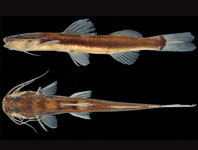Abstract
A recent study based on genomic data by Roxo et al. (2019) provided a phylogeny of the Loricariidae, the largest catfish family and second largest Neotropical fish family with approximately 1,000 species. The study represents a valuable and innovative contribution for understanding higher-level relationships within the family. The phylogenetic tree inferred by Roxo et al. (2019) thoroughly corroborates the monophyly and relationships of most currently accepted subfamilies of Loricariidae, based on a fair taxon sampling (nearly 14% of the species in the family) representing most genera of each but one of the subfamilies, the Lithogeninae, the sister-group of the remaining members of the family (Pereira & Reis, 2017; Reis et al., 2017). In addition to a hypothesis of relationships, Roxo et al. (2019) also proposed a series of lower-level taxonomic changes, which are deemed premature considering that the taxonomic sampling of the study targeted higher-level clades, and go against one of the pillars of biological classification: nomenclatural stability (e.g., Heterick & Majer, 2018; Beninger & Backeljau, 2019). Here we (1) discuss implications of inadequate taxonomic sampling as a basis for changes in classification of species; (2) explain why the taxonomic sampling design of Roxo et al. (2019) is inadequate for the proposed nomenclatural changes; and (3) advocate that changes to classifications must be grounded on phylogenies with dense sampling of taxa at the relevant level.
References
Beninger, P.G. & Backeljau, T. (2019) Understanding taxonomic and nomenclatural instability – a case study of the Manila clam. Aquaculture, 504, 375–379.
https://doi.org/10.1016/j.aquaculture.2019.02.016
Calegari, B.B., Gill Morlis, W. & Reis, R.E. (2017) A new species of Otothyropsis (Siluriformes: Loricariidae) from the upper Río Paraná basin, Paraguay, with a discussion of the limits between Otothyropsis and Hisonotus. Zootaxa, 4244 (2), 231–245.
https://doi.org/10.11646/zootaxa.4244.2.5
Cramer, C.A., Bonatto, S.L. & Reis, R.E. (2011) Molecular phylogeny of the Neoplecostominae and Hypoptopomatinae (Siluriformes: Loricariidae) using multiple genes. Molecular Phylogenetics and Evolution, 59, 43–52.
https://doi.org/10.1016/j.ympev.2011.01.002
Farris, J.S. (1976) Phylogenetic classification of fossils with recent species. Systematic Zoology, 25, 271–282.
https://doi.org/10.2307/2412495
Heath, T.A., Hedtke, S.M. & Hillis, D.M. (2008) Taxon sampling and the accuracy of phylogenetic analyses. Journal of Systematics and Evolution, 46, 239–257.
Heterick, B. & Majer, J. (2018) The taxonomic stability imperative. Australian Zoologist, 39, 627–632.
https://doi.org/10.7882/AZ.2017.031
Hillis, D.M. (1998) Taxonomic sampling, phylogenetic accuracy, and investigator bias. Systematic Biology, 47, 3–8.
https://doi.org/10.1080/106351598260987
ICZN [International Commission of Zoological Nomenclature] (1999) International Code of Zoological Nomenclature. 4th Edition. Published by the International Trust for Zoological Nomenclature, Natural History Museum, London, 306 pp.
Martins, F.O., Britski, H.A. & Langeani, F. (2014) Systematics of Pseudotothyris (Loricariidae: Hypoptopomatinae). Zoological Journal of the Linnean Society, 170, 822–874.
https://doi.org/10.1111/zoj12107
Pereira, E.H.L. & Reis, R.E. (2017) Morphology-based phylogeny of the suckermouth armored catfishes, with emphasis on the Neoplecostominae (Teleostei: Siluriformes: Loricariidae). Zootaxa, 4264 (1), 1–104.
https://doi.org/10.11646/zootaxa.4264.1.1
Pollock, D.D., Zwickl, D.J., Mcguire, J.A. & Hillis, D.M. (2002) Increased taxon sampling is advantageous for phylogenetic inference. Systematic Biology, 51, 664–671.
https://doi.org/10.1080/10635150290102357
Reddy, S., Kimball, R.T., Pandey, A., Hosner, P.A., Braun, M.J., Hackett, S.J., Han, K.-I., Harshman, J., Huddleston, C.J., Kingston, S. Marks, B.D., Miglia, K.J., Moore, W.S., Sheldon, F.H., Witt, C.C., Yuri, T. & Braun, E.L. (2017) Why do phylogenomic data sets yield conflicting trees? Data type influences the avian Tree of Life more than taxon sampling. Systematic Biology, 66, 857–879.
https://doi.org/10.1093/sysbio/syx041
Reis, R.E. (2017) Unexpectedly high diversity in a small basin: A taxonomic revision of Eurycheilichthys (Siluriformes: Loricariidae), with descriptions of seven new species. Neotropical Ichthyology, 15, e160068.
https://doi.org/10.1590/1982-0224-20160068
Reis, R.E., Calegari, B.B., Carvalho, T.P., Cramer, C.A., Delapieve, M.L.S., Lehmann A.,P. & Pereira, E.H.L. (2017) A phylogeny of the armored catfishes, with emphasis on the Neoplecostominae-Hypoptopomatinae clade (Siluriformes: Loricariidae): Integrating phenotypical and molecular data. II International Symposium on Phylogeny and Classification of Neotropical Fishes, Londrina, Brazil, 2017. [unkown pagination]
Reis, R.E. & Schaefer, S.A. (1998) New cascudinhos from southern Brazil: systematics, endemism, and relationships (Siluriformes, Loricariidae, Hypoptopomatinae). American Museum Novitates, 3254, 1–25.
Ribeiro, A.C., Carvalho, M. & Melo, A.L.A. (2005) Description and relationships of Otothyropsis marapoama, a new genus and species of hypoptopomatine catfish (Siluriformes: Loricariidae) from rio Tietê basin, southeastern Brazil. Neotropical Ichthyology, 3, 489–498.
https://doi.org/10.1590/S1679-62252005000400006
Rossini, B.C., Oliveira, C.A.M., Melo, F.A.G., Bertaco, V.A., Astarloa, J.M.D., Rosso, J.J., Fauto, F. & Oliveira, C. (2016) Highlighting Astyanax species diversity through DNA barcoding. Plos One, 11, e0167203.
https://doi.org/10.1371/journal.pone.0167203
Roxo, F.F., Albert, J. S., Silva, G.S.C., Zawadzki, C.H., Foresti, F. & Oliveira, C. (2014) Molecular phylogeny and biogeographic history of the armored neotropical catfish subfamilies Hypoptopomatinae, Neoplecostominae and Otothyrinae (Siluriformes: Loricariidae). PlosOne, 9, e105564.
https://doi.org/10.1371/journal.pone.0105564
Roxo, F.F., Ochoa, L.E., Sabaj, M.H., Lujan, N.K., Covain, R., Silva, G.S.C., Melo, B. F., Albert, J. S., Chang, J., Foresti, F., Alfaro, M.E. & Oliveira, C. (2019) Phylogenomic reappraisal of the Neotropical catfish family Loricariidae (Teleostei: Siluriformes) using ultraconserved elements. Molecular Phylogenetics and Evolution, 135, 148–165.
https://doi.org/10.1016/j.ympev.2019.02.017
Roxo, F.F., Silva, G.S.C., Ochoa, L.E. & Zawadzki, C.H. (2017) Description of a new species of Gymnotocinclus from the rio Tocantins basin with phylogenetic analysis of the subfamily Hypoptopomatinae (Siluriformes: Loricariidae). Zootaxa, 4268 (3), 337–359.
https://doi.org/10.11646/zootaxa.4268.3.2
Smith, W.L. & Craig, M.T. (2007) Casting the Percomorph net widely: The importance of broad taxonomic sampling in the search for the placement of serranid and percid fishes. Copeia, 2007, 35–55.
https://doi.org/10.1643/0045-8511(2007)7[35:CTPNWT]2.0.CO;2
Swofford, D.L., Olsen, J.L., Waddell, P.J. & Hillis, D.M. (1996) Phylogenetic inference. In: Hillis, D.M., Moritz, C. & Mable, B.K. (Eds.), Molecular systematics. Sinauer Associates, Sunderland, pp. 407–514.
Wiley, E.O. (1979) An annotated Linnean hierarchy, with comments on natural taxa and competing systems. Systematic Zoology, 28, 308–337.
https://doi.org/10.2307/2412585
Zwickl, D.J. & Hillis, D.M. (2002) Increased taxon sampling greatly reduces phylogenetic error. Systematic Biology, 51, 588–598.
https://doi.org/10.1080/10635150290102339

